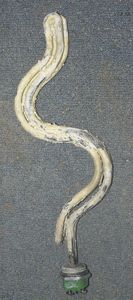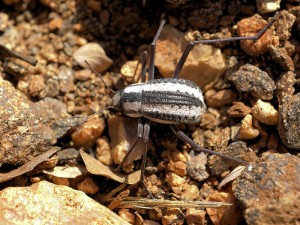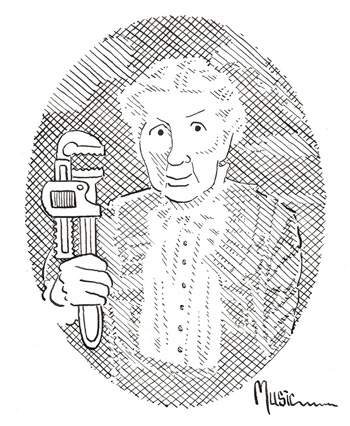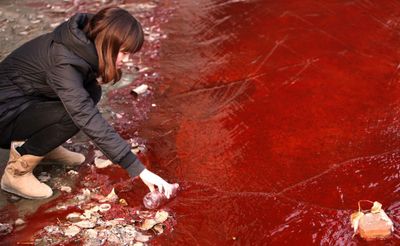Water
News for November 2012
While you were voting, feasting, and shopping, a lot of important things happened in the interesting world of water. Read on to hear all about it.
The EPA Has Launched A Program, SepticSmart, To Help Homeowners Care for Their Septic Systems: 1/4 of Americans Now Use Septic Tanks
According to the U.S. Census Bureau, nearly 25 percent of U.S. households—more than 26 million homes—and almost one-third of new developments are serviced by septic systems. If properly built and properly maintained, a septic system can provide years of trouble-free and environmentally safe disposal of wastewater and sewage for a home.
A septic system typically consists of a septic tank and a drain field for the absorption of wastes. The picture below from the EPA’s website shows a standard septic setup:
Here’s how it works:
-
All water leaving the home is directed via a single pipe into a septic tank.
-
The septic tank is a buried, water-tight container usually made of concrete, fiberglass, or polyethylene. Its job is to hold the wastewater long enough to allow solids to settle down to the bottom (forming sludge), while the oil and grease float to the top (as scum). Compartments and a T-shaped outlet prevent the sludge and scum from leaving the tank and traveling into the drainfield area.
-
The liquid wastewater ( effluent) then exits the tank into the drainfield. If the drainfield is overloaded with too much liquid, it will flood, causing sewage to flow to the ground surface or create backups in toilets and sinks.
-
Finally, the wastewater percolates into the soil, naturally removing harmful coliform bacteria, viruses, and nutrients.
To aid septic tank owners, the EPA recently launched is “SepticSmart” program to promote proper septic system care and maintenance. This national program aims to educate homeowners about proper daily system use and the need for periodic septic system maintenance. SepticSmart also provides industry practitioners, local governments and community organizations with tools and materials to educate their clients and residents.
Here are some basic tips from SepticSmart:
- Spread out laundry and dishwasher loads throughout the day. Consider fixing plumbing leaks and installing faucet aerators and water-efficient products. Too much water use at once can overload your system, particularly if it hasn’t been pumped in the last couple of years.
- Avoid pouring fats, grease and solids down the drain, which can clog your system.
- Homeowners should have their septic system inspected every three years by a licensed contractor and have their tank pumped when necessary, generally every three to five years. Regular inspection and pumping of a septic system can save homeowners from costly repairs—on average, it costs homeowners $250 to pump their septic system, while the average cost of replacing a conventional septic system is $5,000 – $10,000. As the holidays approach, consider having your tank inspected and pumped.
- Ask guests to only to put things in the toilet that belong there. Dental floss, disposable diapers and wipes, feminine hygiene products, cigarette butts, and cat litter can clog and potentially damage septic systems.
- Remind guests not to park or drive on your system’s drainfield because the vehicle weight could damage buried pipes or disrupt underground flow causing system backups and floods.
For more information, visit www.epa.gov/septicsmart.
Editor's Note: EPA also regulates cesspools. Read about cesspools, aka drywells, in the Pure Water Gazette.
 |
| The First Serious 2012 Holiday Shopping Injury Involved a Texas Woman Rushing for A Countertop Water Filter. Details Here. |
Hardness Scale: The Enemy of Pipes, Appliances, and Domestic Tranquility.
Water Treatment 101: Scale
Editor's Note: The following is from a Pure Water Gazette series we've just started getting serious about, called Water Treatment 101. The series aims to present a simple version of what are sometimes complex water treatment issues.
Scale can be a serious problem for both city water and well water users. Scale is caused by the deposit of hardness minerals (mainly calcium and magnesium) on the surface of pipes and fixtures. Hardness can block piping systems, causing the loss of water pressure due to reduced pipe diameter, and it can greatly reduce the effectiveness of home heating systems and hot water heaters. Scaled pipes and appliances waste energy and money.
Scaling is caused by hardness of water. Hardness is defined, in simple terms, as the amount of calcium and magnesium present in the water. Hardness is measured either in parts per million or in grains per gallon. Water treatment professionals most often use grains per gallon. The conversion is easy: a “grain” is equal to about 17.1 parts per million.
Although there is no absolute standard, water is usually considered hard enough to cause problems at about 4 grains per gallon, and it is considered hard enough to require treatment at 7 grains per gallon and up. There is no upper limit on hardness, but water of 100 grains per gallon is fairly rare.The EPA does not set a limit on hardness.
The standard residential treatment for hard water is the conventional water softener, which exchanges sodium ions for the hard water minerals, calcium and magnesium. Conventional softeners are proven, reliable tools. They use salt in the softening process. In recent years a number of electronic and non-electronic softener substitutes have come on the market. Some of these are more effective than others. Template Assisted Crystallization (called TAC) is now the most widely used of the alternative scale preventives. TAC units not only prevent scale buildup but they remove existing scale as well.
 |
| Badly scaled water heater element after only 40 days service on 26 grain hard well water. (Click picture for larger image.) |
Another Expert Says That People Are Being Urged To Drink Too Much Water. People Are Being Told to Drink More Water Than They Need.
The Gazette has long taken the position that the “8 glasses per day” advice usually given by the medical community is pure nonsense. A researcher at La Trobe University agrees.
Spero Tsindos of La Trobe University, writing in the June 2012 issue of Australian and New Zealand Journal of Public Health, asserts that our bodies need about two liters of fluids per day, not two liters of water specifically. The Gazette has frequently pointed out that the water in the foods we eat is water, so people have vastly different needs for actual water since diets vary considerably.
Mr Tsindos believes that encouraging people to drink more water is driven by vested interests rather than a need for better health.
“Thirty years ago you didn’t see a plastic water bottle anywhere, now they appear as fashion accessories, he writes. “As tokens of instant gratification and symbolism, the very bottle itself is seen as cool and hip.”
He also discusses the role of water in our constant quest for weight loss. “Drinking large amounts of water does not alone cause weight loss. A low-calorie diet is also required. Research has also revealed that water in food eaten has a greater benefit in weight reduction than avoiding foods altogether. We should be telling people that beverages like tea and coffee contribute to a person’s fluid needs and despite their caffeine content, do not lead to dehydration.”
Tsindos says that people need to maintain fluid balance and should drink water, but also consider fluid in unprocessed fruits and vegetables and juices of equal importance.
More Information.
Nano Technology Company Claims Invention of a Self-Filling Water Bottle
An enterprising nanotechnology company believes that it has created a marvelous self-filling water bottle by imitating the natural process of hydration used by the Namib Desert beetle.
NBD Nanotechnologies has imitated the beetle’s uncanny ability to extract water from dry desert air. The beetle lives in one of the world’s most arid regions (about 1/2 inch of rainfall per year) and has developed a unique survival technique by drinking water that it gets from tiny droplets that its bumpy back collects from the atmosphere.
 |
| The Namib Desert beetle drinks by the clever use of its own bumpy back surface, which provides for accumulation of water droplets of fifteen to twenty micrometers in diameter. |
Here’s how one writer describes the process:
To drink water, the Namib beetle (genus Stenocara) stands on a small ridge of sand. Facing into the breeze, with its body angled at forty-five degrees, the beetle catches fog droplets on its hardened wings. Its head faces upwind, and its stiff, bumpy outer wings are spread against the damp breeze. Minute water droplets from the fog gather on its wings; there the droplets stick to hydrophilic bumps, which are surrounded by waxy, hydrophobic troughs. Droplets accumulate and coalesce until their combined weight overcomes the water’s electrostatic attraction to the bumps as well as any opposing force of the wind; in a thirty-kilometer-an-hour breeze, such a droplet would stick to the wing until it grows to roughly five millimeter in diameter; at that point it would roll down the beetle’s back to its mouth parts.
The water droplets in fog are, on average, just one one-thousandth of an inch across, and the largest ones are only twice that size. The droplets are so small, in fact, that they often don’t fall downward; instead they get carried sideways or even upward by currents of wind.The trick to drinking fog is getting the droplets to aggregate, so that wind and electrostatic forces no longer overwhelm gravity. When a wind-blown fog droplet lands on a hydrophilic (water-loving) surface, such as clean glass or stone, the drop flattens out because of the electrostatic attraction between the molecules of water and those of the surface. The cross section of the flat drop is too small for the wind to pick it back up. And, because water molecules so strongly attract each other, the flat drop also presents a highly hydrophilic surface to which other droplets can attach.
To mimic nature, NBD Nanotechnologies layered a surface with hydrophilic and hydrophobic coatings, used a fan to pass air over the surface, and managed to get water to condense. This eventually led to the design of a conceptual self-filling water bottle.
The best part, according to the developer, is that it uses virtually no energy and can be run entirely by solar cells and a rechargeable battery.
The company points out that there are more than three quadrillion gallons of water in the air, making it a massive untapped resource.
Whole House Water Filters
“Whole house” water filters for city water users can be either cartridge-style or tank-style. Cartridge filters are in general more compact and relatively easy to maintain. They are also a bit easier to install. Tank-style filters are larger and offer longer service runs between media changes. Tank-style filters are also less restrictive of water flow.
The main purpose of whole house filters for city water users is the removal of the disinfectants chlorine or chloramine added by the city. This means that carbon in some form is almost always the medium of choice. Carbon is sometimes combined with KDF for enhanced performance, but carbon is virtually always the workhorse. (This article is about filters. Water softeners, which are similar in appearance to tank-style filters, are not filters and are not being considered here.)
Removing disinfectants fixes most taste/odor issues and almost always improves water aesthetically. Disinfectant-free water is much more pleasant for bathing and general household use. Chlorine-free shower water is definitely a health advantage, as evidence grows of chlorine's bad effects on the skin and the body in general. Breathing chlorine given off in shower water is clearly a negative to health. Some people are more sensitive to chlorine and chloramine than others, and to them using a good dechlorinating or dechlromaminating filter can be a life-changing advantage. Added advantages to having a whole house carbon filter include the removal of the by-products of disinfection (THMs) and other extraneous chemicals that might be in the water and protection of water softeners (softeners are always installed after the whole house filter, which protects their resin from degradation). Disinfectant-free water is preferred for almost any household function.
Frequently Asked Questions
Will this filter give me great drinking water at every tap in my home?
No. A whole house filter isn't a substitute for a drinking water filter. Drinking water units get to handle the water much more slowly and in limited quantity, so they can be made much tighter and therefore more effective. It's also easy to add extra media to treat lead, arsenic, fluoride, etc. in small drinking water units. This is not practical for a whole house city water filter, which is mainly a disinfectant remover. This is not to say, however, that with a whole house filter you won't be able to get a glass of tasty, much improved water from any tap in your home.
Do your whole house filters remove fluoride?
No. Filter carbon can remove some fluoride under the right conditions, but this isn't a reliable or easily predictable property of carbon. Fluoride can be removed handily from drinking water by reverse osmosis or by specialty filter media like activated alumina.
A few websites sell whole house fluoride filters. Why don't you?
Mainly because we don't believe that they can be made to work as advertised. For fluoride removal with the standard fluoride media, the rate of flow would need to be very slow and the filter or filters gigantic. With current technology, whole house fluoride reduction isn't practical. The best way at present to get fluoride out of your bath water is to bitch persistently at your city government for adding it to the water. Most of the enlightened world has rejected public water fluoridation, and an increasing number of cities are dropping fluoridation as a bad idea.
How can I be sure the filter is removing all the chlorine or chloramine from my water?
Actually, you can be sure that it isn't removing all the disinfectants or all of anything else. Water treatment is always about reduction, not complete removal. Not even the best steam distiller removes all of anything. When an advertiser promises that his filter removes 99% or 97% of the chlorine or chloramine, he's counting on the fact that you have no way to test his claim. (To test this with any degree of accuracy, the filter would have to be installed in a qualified testing laboratory.) He is also relying on the fact that big filters are so cumbersome that returning one that's had water in it is essentially impossible.
Disinfectant reduction depends on so many variables that accurate prediction of results is not feasible. You have to consider rate of flow (the most important of all, and one of the few variables you have some control over), water temperature, mineral content, turbidity, and pH of the water, amount of chlorine/chloramine, length of service flow cycles, et al.
The most practical way to measure disinfectant reduction is with simple tests available from pool and pet stores. We think it's fair to assume that you'll get a 90% plus reduction from a whole house filter that's operated with the recommended flow limit—and certainly that enough disinfectant will be removed that you won't be aware of its presence.
How long will the carbon last before I have to change it?
The many variables—flow rate, amount of disinfectant, other factors in the water, the number of gallons of water used—make it impossible to give a precise answer, but in normal residential filters a three or four year service life of the carbon is a reasonable expectation. It can be much longer if conditions are right.
Is changing the carbon a hard job?
In general, it isn't a hard job, but it can be a messy job. It depends on where the filter is installed. If it's accessible, it's a matter of screwing the top off of the filter, like screwing the lid off of a bottle, pouring out the contents, and pouring in new carbon. The carbon is the consistency of coffee grounds, but there's a lot of it, and when it's wet, it's heavy.
Are backwashing filters better than In/Out style filters?
Each style has its advantages and disadvantages.
In/Out units are less expensive to purchase, hold more filter carbon per tank size, require no electricity or drain hookup (making them easier to install), and require no control-valve maintenance.
On the negative side, since they have no way to get rid of trapped particles, In/Out units can be used only on clean water and even so must have a sediment filter installed in front of them to protect against unexpected events like water pipe repairs. Rebedding the filter costs more because more carbon is required.
Backwashing filters can be used to treat dirtier water and the pre-sediment filter is optional, since they can backwash out collected impurities. They have the ability to renew their filter bed to prevent “channeling,” and their performance is more predictable.
Negatives for backwashing filters are higher initial cost, the need for electricity, and the need for access to a drain. Backwashing uses water (50 gallons plus per backwash, depending on the size of the filter) and if done frequently can actually shorten the life of the carbon by physical breakdown. Although backwashing filters are very reliable, they are more complex than In/Out filters and are consequently more likely to need maintenance.
How about KDF? Do you put it into your carbon filter tanks?
KDF is good stuff in its place—in shower filters, for example. Under the right conditions, It can prolong the life of carbon and keep it clean. In general, though, we do not like mixed bed filters because one of the media usually outlasts the other and requires a different backwash regimen. We can provide a small KDF tank to pretreat for your carbon tank, but we don't like putting the two media in the same tank.
How about chloramines? What kind of filter is best for chloramines?
One of the big myths about chloramine is that it can’t be removed. Actually, it is removed with filter carbon, the same filtering agent that very effectively removes chlorine. The difference is that chloramine is much harder to remove. Therefore, it takes more carbon, and water must be given more residence time in the carbon. In other words, you need a larger carbon bed and a significantly slower flow rate to remove chloramine with standard carbon.
A specially prepared carbon, called catalytic carbon and referred to sometimes by the name of the most popular brand, Centaur, is much better at chloramine removal than standard carbons. Catalytic carbon filters can be sized smaller than standard carbon models when used for chloramine reduction.
How large a filter do I need?
This is the hardest question to answer. In general, it's probably impractical to size a residential filter so that its service flow limit is never exceeded. If a treatment professional were planning a system to treat well water known to be contaminated with a dangerous chemical, adequate sizing would be essential. With a residential disinifectant reduction filter, the consequences for going over the limit now and then are a slight reduction in water quality and shortening of the lifespan of the carbon bed.
Filters of this type are sized by gallon per minute (gpm) flow rates. A carbon bed requires certain residence time with the water (the engineering term is EBCT, for "empty bed contact time"). The larger the bed, measured in cubic feet of carbon in the tank, the faster the permissible flow rate. The contact time required for chloramine reduction is much higher than for chlorine reduction.
Reprinted, slightly augmented, from the purewaterproducts.com information articles section.
 |
We've added Watts stainless steel residential UV units to our main website.
UV is our best commercial product. We’ve been selling UV units since 1990. Adding the stainless steel Watts units to our popular line of plastic Pura units gives us a powerful, high output UV system that’s simple to install and maintain yet inexpensive to purchase. Since we are predominantly online sellers, we like products that are tough and effective yet simple enough for non-professionals to install and service. We’ve given the Watts systems a good test and we really like them.
Watts UV units come in popular residential sizes from two to twelve gallons per minute with pipe sizes of 1/2″ (2 gpm unit), 3/4″ (6 and 8 gpm units) and 1″ (12 gpm unit). Even the largest unit is priced under $500.
|
Water News of the Month
Below are November's posts in the Pure Water Gazette's "Today's Top Water Stories" section. A few are included in part in this newsletter. Reading the Gazette's daily posts will make you wiser than you can imagine.
 |
How Water Water Softeners Work
by Pure Water Annie
In response to many, many, many requests, Pure Water Gazette Technical Wizard Pure Water Annie Explains How Conventional Water Softeners Work
|
The diagram above shows the two parts of a standard residential water
softener. On the left, the brine tank which holds the salt that
regenerates the unit, and on the right the water softener itself.
A water softener is an ion exchanger. It is not a water filter.
Hard water—water with a high calcium/magnesium content—enters
the
softener through the “In” port indicated by the green arrow.
It passes
through the control valve and into the main tank, where it goes
from
top to bottom through a bed of resin that “softens”
it.
The resin consists of specially manufactured beads that have been
saturated with sodium
ions. “Softening” occurs as the hardness
minerals, the calcium and magnesium ions, in
the water attach
themselves to the resin and are “exchanged” for
sodium, which goes
into the water in their place.
The softened water then enters the long center tube, called a riser
or a "dip tube,"
via the strainer basket in the bottom of the tank and
passes upward
through the riser. The water then exits the softener
via the
control valve (blue arrow) and is sent to the home.
When the resin becomes saturated by hardness minerals, it no longer
has the ability to soften water. The water softener then automatically
goes into regeneration. The regeneration
process is initiated by a
timer or a meter, depending on the type of
softener. More of this
below. By this process the hardness minerals are
washed down the drain
(via a drain tube not shown in the diagram),
and the resin bed is
rinsed, resettled, and recharged with sodium.
It is now again ready to
soften
water.
The regeneration process is accomplished by passing very salty
water from the brine tank through the resin. The brine solution is so
concentrated that its high sodium content displaces the calcium and and
magnesium ions on the resin.
The brine tank must remain filled with softener salt at all times
so that it can regenerate the softening resin again and again.
For a longer version of of this article.
 |
| The Yangtze River, once the country’s lifeblood, has now turned blood red. Actually, in this case what was first believed to be serious industrial pollution turned out to be red dye that entered the water as the result of a bag recycling operation. |
China Has 20% of the World's Population But Only 6% of the World's Water
Water in China: Some Facts
The United Nations says China is one of 13 countries with extreme water shortages.
The problem is partly demographic. While China has 20% of the world’s population, it holds six percent of the world’s water resources. but is also exacerbated by rapid and short-sighted development. Rapid and short-sighted development have made this built-in shortage of water worse.
Strong economic growth has turned the country into the world’s second largest economy but at the expense of the environment.
The Yangtze River, once the lifeblood of the country, now flows a foreboding blood red, possibly due to industrial pollution.
Chronic droughts plague important agricultural regions like Shandong province, which produces most of China’s grain.
Within a few years, China’s water demand will reach 818 billion cubic meters, experts say, and yet there’s only 616 billion cubic meters available.
Beijing has about 100 cubic meters of water available per person, well below the U.N. standard of 1,000 cubic meters per person, a threshold used to measure chronic water shortage.
To put things in perspective, China has 25 bathtubs of water per person. The U.S. has the equivalent of 125 bathtubs.
China now has around 300 million people with no access to potable water, resulting in some 66,000 deaths per year, according to the World Bank. It estimates the cost of water pollution to China at $22 billion, roughly 1.1 percent of the country’s GDP.
The Chinese government recognizes the problem and is seeking to cut water consumption by 30%.
China’s rapacious water consumption is in part boosted by an illogical scenario: water, while scarce, is unusually cheap. Water in China, in fact, is really three to five times cheaper than it should be. China is trying to reduce consumption by raising water prices, and this has been taking place slowly since 2009.
As with other areas, however, where public consumption becomes the focus of water saving efforts, in China the largest users and the largest polluters of water are industry and agriculture. They use about 85% of the water in China.
As with other countries, a simple step could save immense amounts of water: fixing leaky pipes. There are literally hundreds of millions of miles of pipe laid around the world that are leaking and wasting water. These are some simple fixes that we could do right away.
 |
Numerical Wizard B. Bea Sharper ferrets out the watery facts that Harper's misses
|
Facts You Would Have Learned
Had You Read This Month's Top Water Stories Articles in the Pure Water Gazette
Number of people who live in the Great Lakes region and whose economy is affected by the well being of the lake -- 30 million.
Year when Gray Whales were removed from the Endangered Species list -- 1994.
Round trip distance that gray whales travel to their breeding area -- 12,000 miles.
Factor by which DBPs are more toxic than chlorine -- 10,000 times.
Number of daily glasses of drinking water recommended by "experts" -- 8.
Percentage of the world's water owned by China -- 6%.
Percentage of the world's people who live in China -- 20%.
Deaths per year in China attributed to unavailability of potable water -- 66,000.
Percentage of China's water that is used by industry and agriculture -- 85%.
Percentage of Chinese citizens who drink water -- 100%.
Average annual rainfall in the Namib desert -- 1/2 inch.
Minimum draft required by most Mississippi River freight vessels -- 9 feet.
Average cost of replacing a failed home septic system -- $5,000 to $10,000.
Percentage of US homes that now have septic systems -- 25%.
Gallons of water required to produce $1 worth of dog food -- 140.
Gallons of water required to produce $1 worth of sugar -- 270.
Parts per million of hardness minerals that constitute one "grain" of hardness - 17.1.
Fines assessed again Roquette America for violations of the Clean Water Act -- $4.1 million.
Percent of small public water systems in Tulare County, CA that are unable to meet safe nitrate levels-- 20%.
Pure Water Gazette Now in a New Format
Our information-stuffed variety magazine, the Pure Water Gazette, has taken another turn. The Gazette started as a paper publication in the 1980s. The last paper issue was mailed in 1997. It has existed since as an information-rich website whose navigation and aesthetic properties were suffering from years from neglect. Although the old site can still be seen here, the best of the old content has been relocated to a much more manageable and search-friendly blog-style format. The new site is up and running as a work in progress with
over 400 articles and many more to come. At least one new article is added each day. The new site is at the old location, http://www.purewatergazette.net. Please visit!
|

